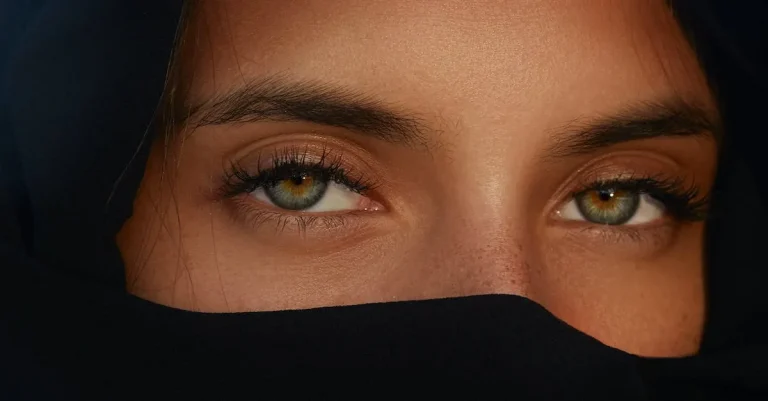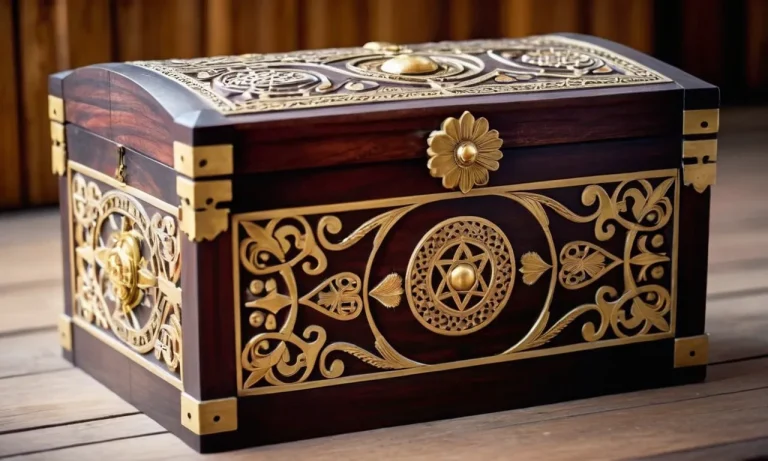The iconic blue evil eye symbol is well-known across many cultures as a protective talisman and symbol of good fortune. But what is the deeper spiritual meaning and history behind this timeless icon?
If you’re short on time, here’s a quick answer: The blue evil eye is thought to protect against the curse of the evil eye, ward off envy, and bring good luck in many spiritual traditions ranging from the Mediterranean to the Middle East and beyond.
In this comprehensive guide, we’ll explore the mythological origins and spiritual symbolism of the blue evil eye amulet in depth. We’ll cover topics ranging from its use in Islam, Judaism and Buddhism to how to make your own nazar to hang in your home for protection and blessings.
The Folklore and Mythology Behind the Evil Eye
The concept of the evil eye across cultures and faiths
The evil eye is a centuries-old folk belief that a malicious glare can inflict harm, bad luck, or injury. This concept has roots across many cultures and faiths, including Ancient Greece, the Islamic world, India, and the Mediterranean.
It’s referenced in ancient texts like the Quran as well as Jewish mystical writing.
While each culture has its own origin stories, the basic premise is similar. The evil eye results from feelings of extreme envy, jealousy, or ill-will and can cause accidental or unusual injuries, sickness, or even disasters.
Legends of the destructive power of envy and ill-will
According to folklore, people with the evil eye were born with this power innately or gained it through life experience. Their gaze was malicious whether intentional or not. There are many legends depicting the destructive power of the evil eye:
- Roman author Pliny the Elder claimed the evil eye could cause hailstorms, blight crops, or dry up rivers.
- Some believe the evil eye played a role in the declining health and eventual poisoning of Alexander the Great.
- In India, the evil eye is blamed for sickness, loss of wealth or job, and death of livestock or family members.
While specifics vary across cultures, all caution that envy breeds resentment which manifests as the evil eye’s curse.
The blue eye as an apotropaic symbol to reflect negativity
Given the malicious nature of the evil eye, protective talismans and rituals have long been used to ward it off. Of these apotropaic (evil-averting) symbols, the blue eye is one of the most ubiquitous and enduring.
In the Middle East and parts of Europe, the blue eye’s origins come from ancient Egypt and the Eye of Horus. The blue hue invokes the Mediterranean Sea and sky deities to provide safety. The blue eye ornament gained popularity as Mediterranean trade spread it.
Soon it became a universal apotropaic amulet.
| Century | Use of Blue Eye Amulet |
| 5th century BCE | Depicted on boats and in homes in Phoenicia |
| 4th century BCE | Worn by Alexander the Great’s navy on shields |
| 1st century CE | Displayed in houses, tombs Roman Empire |
Some believe the blue eye’s protective power comes from mimicking the evil eye itself. Its unblinking stare is thought to reflect negativity back on dangers rather than absorb it. For many today, the blue eye retains symbolic power to ward off harm.
Use of the Blue Evil Eye in Spiritual Traditions
Importance of the nazar in Islam
In Islam, the evil eye, known as nazar, is a dangerous spiritual affliction brought about by another person’s jealousy or envy. Many Muslims believe that the Prophet Muhammad endorsed the notion that the evil eye is real and can cause harm.
To ward off the evil eye in Islamic cultures, the symbol of the eye is embedded in jewelry, amulets, clothing, vehicles, and even architecture. The color blue is thought to have a protective power, hence the prevalence of blue eye charms.
Common examples seen today include the hamsa hand and the blue glass eye charm.
Some passages in the Quran instruct people to avoid negative emotions like jealousy and envy which are believed to attract the evil eye (see surah 113 and 114). Hadiths attributed to Muhammad also warn people against the dangers of the evil eye.
Kabbalistic views and the hamsa in Judaism
In Jewish Kabbalistic theology, the left eye represents the evil eye, while the right eye symbolizes the good eye. The penetration of the evil eye corresponds to the entrance of evil into a person’s soul. The blue hamsa hand common in the Middle East features an eye symbol to ward off such evil.
The hamsa hand meaning has deeper roots in Judaism’s Kabbalistic tradition, where the five fingers are said to represent the five senses and symbolize God’s protective presence and guidance. While the evil eye meaning stems from negative vibrations, the hamsa hand counters with positive energy to keep harm at bay.
The eye imagery in Buddhism and Eastern faiths
In Buddhism, the eyes are believed to be windows into the mind, and the state of one’s eyes and vision is related to spiritual development. Sharper vision allows increased awareness and insight. An intact eye symbolizes internal vision, introspection, and perception of the true nature of reality.
The evil eye concept manifests differently in Buddhism and Eastern faiths than the Middle East. Rather than warding off envy or ill intent, the focus centers on overcoming inner afflictions and mental disturbances which blur one’s inner eye and spiritual vision.
Protective eye symbolism in statues or amulets act as reminders to cultivate one’s own mental clarity and insight.
| Faith | Use of Eye Symbolism |
|---|---|
| Islam | Ward off harm from envious glances/evil eye (nazar) |
| Judaism | Counter negative vibrations, symbolize God’s guidance |
| Buddhism | Represent inner vision, introspection, see truth of reality |
How to Make and Use a Blue Evil Eye Talisman
Selecting evil eye beads and supplies
When selecting materials for your blue evil eye talisman, opt for glass or plastic beads in shades of dark blue, light blue, white, black or turquoise (1). These shades are thought to deflect negative energy most effectively.
You’ll also need cord or string, and optionally decorations like sequins or beads in complementary colors. Purchase supplies from a craft store or online marketplace.
Step-by-step crafting instructions
Follow these steps to craft your own protection amulet against the evil eye:
- Cut a piece of string or cord 8 inches long. Tie a knot at each end.
- Thread evil eye beads onto the string, alternating colors if using more than one shade. Add decorative beads or sequins if desired.
- Tie knots between each bead, and a knot on both sides of the sequence to secure it on the cord.
- For the final step of crafting, tie the ends together to form a bracelet or necklace that can be worn.
Tips for activating and consecrating your amulet
An important step after physically making the talisman is spiritually activating it to enhance its protective capacities. Here’s how:
- Perform a ritual to concentrate energy into the piece, such as holding it while meditating, reciting a prayer or mantra intention, or envisioning it filled with bright blue light.
- Pass the amulet through incense smoke or sprinkle with holy water if these practices align with your beliefs.
- Wear or carry the activated talisman to defend against envy, ill-wishing and the draining effects of the evil eye.
Proper use for spiritual protection
An evil eye amulet serves as an important tool in many spiritual traditions for protecting oneself from negative intentions and bad luck. For most effective use:
- Keep the talisman visible when protection is desired by wearing it as jewelry or hanging it in a home, car or workspace.
- Renew talismans regularly on the new moon by re-activating old or crafting new ones for optimal potency.
- Gift an evil eye amulet to family, friends and colleagues to shield their wellbeing and good fortunes from harm.
With the above guide, anyone can craft and activate their own beautiful blue evil eye defense against ill-meaning energy according to custom. Stay mindfully protected with this important spiritual ally closeby!
Decorating Your Home With the Blue Evil Eye
Hanging evil eye welcome decor inside and out
Welcoming guests with a brightly hued evil eye decoration displayed prominently on your front door or entryway communicates protection, blessings and positivity to all who enter (1). You can find evil eye welcome plaques, door hangers and wreaths in traditional designs featuring the iconic large staring blue eye.
Or for a modern twist, opt for abstract evil eye patterns in cool blues and whites on doormats, wooden signs or metal wall art.
Inside your home, hang framed Turkish evil eye tapestries above seating areas where families and friends gather together. The vibrant cobalt blue and white beads are both protective and aesthetically pleasing.
For the kitchen, oven mitts, aprons and dish towels embroidered with the classic staring eye make functional yet meaningful gifts.
Incorporating Nazar motifs into textiles and jewelry
From table runners to pillow shams, bed sheets and blankets, today’s textiles allow you to incorporate the Nazar motif across any room. Intricately woven Turkish rugs prominently display patterns of symmetrical eyes, sometimes intermixing other regional symbols of blessings.
For personalized decorative pillows, custom fabric designers can recreate favorite Nazar patterns to complement your décor.
Jewelry is another decorative way to keep the evil eye close across daily activities. Popular picks are silver or gold bracelets showcasing a center blue eye bead, and earrings in modern geometric shapes or with dangling blue beads.
The blue evil eye symbol also makes meaningful pendants, rings, charms and amulets. Many companies use glass artisans to craft beads by hand, some even containing chips of Turkish blue evil eye stone.
Gifting protective blue evil eye tokens to loved ones
Gifting family, friends or even co-workers a blue evil eye token conveys your heartfelt wish for their protection and happiness. For children, pick fun evil eye stickers for their notebooks, skateboards or bedroom walls. Teenagers might appreciate a stylish evil eye phone case cover.
Adults could use an understated leather wallet embroidered with a small evil eye icon.
When selecting an evil eye gift or home accessory, know that different eye styles and colors hold special meaning. The most classic evil eye beads are circular in an intense blue, representing warding off harm. Longer, ellipse eyes stand watch more aggressively.
Black bead evil eyes specifically target envy’s effects. Large, solitary eyes imply supreme power. Ultimately, the evil eye’s meaning lies in its giver’s intention to protect someone from negativity or misfortune.
Conclusion
With its enduring mystical legacy across continents and faith traditions, the blue evil eye continues to hold deep spiritual resonance as a protective force. Learning about the mythic roots and symbolic meaning of the classic Nazar amulet gives greater insight into this iconic token that still wards off envy and harm in homes today.
By wielding the blue eye’s timeless power with proper understanding and respect, we bring good fortune to ourselves and all who visit our sacred spaces.






